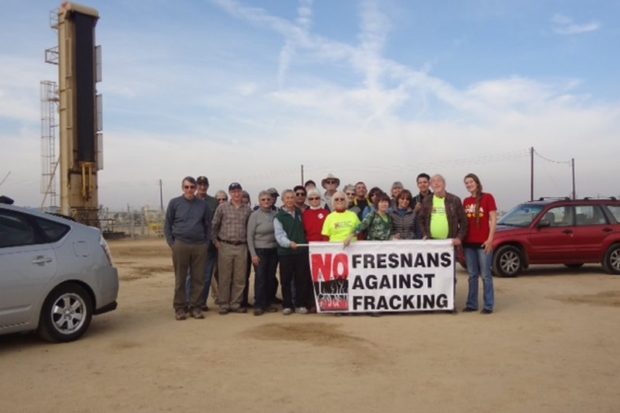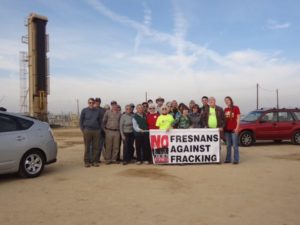
By Alan Cheah

On Jan. 11, Fresnans Against Fracking, led by local activist Gary Lasky, participated in a caravan to Shafter for a tour of its fracking fields. Many of us know about the ills of hydraulic fracturing in the abstract but rarely do we get an opportunity to see it firsthand with a guide intimately familiar with the land, its history and politics.
Tom Frantz, 64, an almond farmer whose family has worked these fields for more than 100 years, is founder of the Association of Irritated Residents (AIR). Fifteen years ago, Frantz recognized that the quality of life in his beloved Kern County is not sustainable with the continuing onslaught of land, water and air pollution from mega dairies, coal, oil, biomass plants and hazardous waste from Southern California.
Within minutes of Frantz’s home we witness strange bedfellows—conventional oil donkeys and newer elevator-style pumps alongside almond orchards and other crop fields. Elevator-style pumps are necessary because frack wells are so deep conventional pumps won’t do. Fracked wells go down 2,000-plus feet then gradually curve another 5,000 feet or approximately 1 mile to a horizontal position and extend as much as another 2 miles.
We didn’t witness an actual fracking operation, but we did see some of the equipment used. It takes three 1,000-hp diesel engines to run a drilling rig. Once the pipes are in place and perforated, a cluster of pipes referred to as the Christmas tree is used to mix a cocktail of water, sand and toxic chemicals that is injected into the well at high pressure creating fissures from which oil can be extracted. The water stored in blue shipping container style tanks is taken from farmers selling their allotment, fire hydrants and the federally subsidized Friant-Kern canal.
Along our journey, we see gas oil separation plants basically cleaning the adulterated oil coming from the ground. We see 20-foot stacks blowing 10-foot flames. It didn’t seem like the barren wasteland I pictured perhaps because these oil fields were nestled among orchards and farmers’ homes.
Surprisingly, everything seemed quite benign until we learned what was coming out of those flare stacks and what’s in the wastewater and where it went. Flaring is done during well production testing and can last days to weeks. Each stack can burn upward of 500,000 cubic feet per day—enough to power 3,000 homes per day. Although flare gases are mostly natural gas, most natural gas is methane, which is 72 times more potent than carbon dioxide as a greenhouse gas over 20 years.
Then there is the flow-back wastewater commonly referred to as produced water. It is disposed of by injecting it back into the earth, which contributes to increased earthquake activity. Recycling it creates a highly concentrated sludge, which is not regulated and poses an extremely high risk to drinking water. The produced water also ends up in evaporation ponds.
From here on, it got uglier. We drove up to one evaporation pond. We didn’t stay long as many of us were immediately experiencing irritation in our eyes and throats. Hydrogen sulfide from produced water is also known “knock down” gas. In high concentrations, it can cause loss of consciousness and death. And here it is stored in unlined pools.
The worst is yet to come. We headed toward the North Belridge oil fields located about 30 miles west of Shafter. I thought I was on location of the filming of Mel Gibson’s Mad Max movies. Instead of desert fast attack vehicles roaming the barren landscape in search of gasoline, liquid container trucks dart back and forth carrying water and produced water. Signs by Exxon-Mobil, Chevron’s Aera Energy and Occidental Petroleum were proudly displayed. Ironically, the roads were littered with safety signs 200 yards apart.
There are currently 15,000 wells in the area with an expected expansion of 3,000 per year into the foreseeable future. Fracking in Kern County’s Monterey shale is in its infancy compared to the Bakken shale in North Dakota, the Barnett shale in Texas and the Marcellus shale in Pennsylvania. The Monterey shale is believed to be the largest in the United States. The greater danger, as though we need one, is fracking’s impact on global climate change. If allowed to continue, it’s game over for Mother Nature.
A sense of futility washed over me until I went to the Food and Water Watch Web site and discovered hundreds of cities have passed resolutions against fracking. We must act now. For more information, contact Gary Lasky of Fresnans Against Fracking at data.nations@gmail.com or 559-790-3495.
*****
Alan Cheah is a contributing columnist at the Sierra Star. Contact him at alaninoak@gmail.com.
